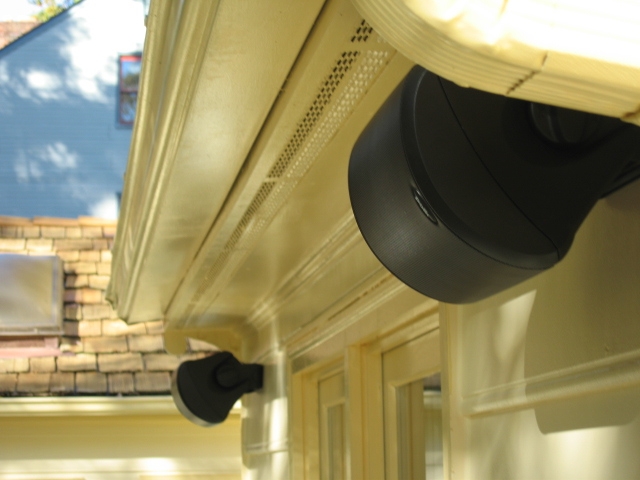An outdoor speaker system is a great way to extend and enhance your home theater experience. Just think about it: instead of being confined to a single room inside the house to listen to your favorite music or watch your favorite movies, you have the option of taking the experience outdoors: in the backyard, at the patio, by the pool.
Of course, buying, installing, and maintaining an outdoor speaker system will present challenges that are different from the ones you’re normally used to. It will also mean setting up a listening environment that can withstand natural elements (like water / moisture, dirt, heat, and background noise) and perform despite the lack of your usual sound-reinforcing walls.
To help you set up, install, and take care of your outdoor speaker system, we here at Hooked Up Installs have come up with this quick guide on outdoor speakers.
Buying Outdoor Speakers
- Choose outdoor speakers that feature a low-frequency response of 60 Hz or below. This should help your system produce a richer, deeper sound, and enable you to hear the bass of your favorite house tracks or blockbusters despite the background noises of the outdoors.
- If you are willing to shell out extra cash, get a subwoofer, which will help you reproduce low-pitched audio frequencies for a better and more consistent listening experience.
- If you’re setting up your system in a wide open space, look for speakers that are specifically designed to withstand elements like rain, snow, dirt, extreme temperatures, moisture, etc. Good audio systems are not only great-sounding; they’re also durable.
- If the speakers come with mounting brackets, be sure to follow the manufacturers’ manual or consult professional installation help.
Installation
- Mount the outdoor speakers high enough so that the sound can be projected at greater distances. On the other hand, we recommend that you don’t go higher than ten feet; otherwise, the sound from the speakers will likely thin out.
- Think carefully about the locations where you’ll be doing most of your listening. This will help you decide how to carefully place your speakers in such a way that they alternate between the left and right channels.
- To improve the bass output of your outdoor audio, place the outdoor speakers near a solid surface or a wall.
- Unless your speakers are specifically designed for poolside use, avoid placing them near water features (like your swimming pool, Jacuzzi, or koi garden).
- Add a volume control box to your outdoor audio system, so that you won’t have to go inside your house to adjust the volume of your outdoor speakers.
Maintenance
- If you’re mounting your speakers with a bracket, go for a protected location (such as under a roof) that allows your system to last longer while performing at an optimum level.
- If you’re running the speakers underground (a common feature of outdoor rock speakers), we recommend that you use “direct burial” wires, which are designed to handle extreme temperatures and moisture conditions. For added protection, run the wire through a PVC conduit, so that the gardener doesn’t cut through it one random weekend. Also, make sure (with silicon or some other protective sealant) that you seal the holes through which your wiring runs. This will protect your system from insects and moisture and dirt buildup.
- Save a few feet of wire and coil them up under your outdoor speakers. Why? So that you will not have to do the underground wiring all over again in case you need to transfer the speakers to another, more optimal location.
- If you run underground cable to a “planter” or “rock” speaker, you may want to coil up a few extra feet of wire and place it directly under the speaker. This way, you’ll have some extra wire if you decide to move the speaker later on, and won’t need to redo the entire underground run.



Hi, I live on Chickamauga Ln, not too far from Ivy Hall Elementary and I recently bought some outdoor rock speakers from http://www.outeraudio.com/outdoor-rock-speakers/ in an attempt to spruce up our backyard.
Can you maybe assist me with the installation?
Hey Serena,
We’d be happy to help! Head over to http://www.hookedupinstalls.com/contact-us/ and schedule an estimate or call us directly.
Look forward to hearing from you!
I really appreciate your tip on how you can get speakers that specifically are made to withstand the elements! My wife and I have been thinking of getting some speakers for our back patio so we can entertain. I will be sure to only buy speakers that are made to be outside!
I wanted to thank you for the advice for getting outdoor speakers. You said that you need to have the speakers high enough so the sound can be projected. This seems useful for a lot of other events as well, like even for large room that will have some kind of sound system so that the sound won’t be blocked by crowds of people.
It was helpful when you mentioned that you should get speakers that can withstand the elements of where it will be placed. My wife and I want to get speakers for our block parties. I will be sure to get some that will withstand the outdoor elements.